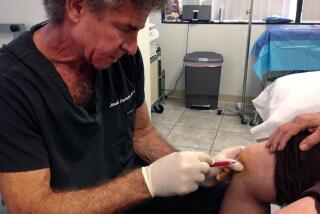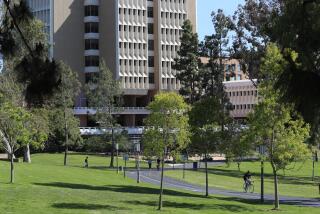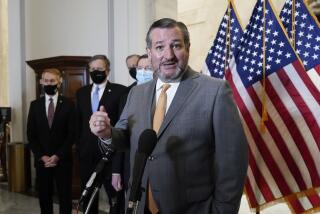Scientist offers free cell lines
WASHINGTON — A privately funded Harvard University researcher will soon begin creating stem cell lines for himself and other academic researchers from discarded embryos provided by a large Boston fertility clinic, an arrangement that could dramatically enhance the supply of cells available for study.
However, research on these cells could not be conducted using federal money, since these cell lines would be established subsequent to those 60 lines identified by the National Institutes of Health and allowed under President Bush’s recent decision.
The deal--unusual in that most privately funded stem cell lines are created by companies for commercial purposes--could serve as a catalyst for other private interests to support academic researchers who otherwise are largely dependent on federal grants. Because these stem cell lines would be new, they could be more valuable to researchers than the existing lines, whose age and viability have not been disclosed. The arrangement, first reported in Friday’s Boston Globe, was not “a response to President Bush’s thinking and decision,” said Douglas Melton, chairman of Harvard’s cell and molecular biology department.
In an interview Friday, Melton said he first drafted the proposal more than a year ago and sought approval from his employer, the Howard Hughes Medical Institute.
“I wasn’t confident that academic researchers could rely on companies to supply these cells,” said Melton, who works for the Maryland-based private medical foundation while also serving on the Harvard faculty. “It seemed reasonable to have an independent, noncommercial source of embryonic stem cells.”
Boston IVF, an organization of fertility clinics based in Waltham, Mass., will supply the embryos after donor couples consent for them to be destroyed, which occurs when stem cells are extracted from them. The clinic will receive $180,000 from the institute to provide the embryos, the Globe reported. Melton said he intends to make the cells available free to any researchers “for any legitimate research purposes, without restriction.”
Companies usually charge several thousand dollars to provide such cells, even to academic researchers. The Wisconsin-based, nonprofit WiCell Research Institute, for example, charges $5,000 for human stem cells from a single source shipped in the United States and $6,000 for such cells shipped internationally.
Melton said it is important to have many cell lines readily available for researchers because even “immortal” cell lines--batches of cells from a single source--deteriorate with age.
“A line is immortal in the sense that it will continue to grow and divide forever--but with age . . . they poop out. Imagine if you got a person to live forever. That doesn’t mean the person will have the same properties at 150 as a 25-year-old. So you need different lines.”
If it turns out that the 60 lines approved by Bush “are not sufficiently robust, this would provide a backup source of cells specifically for those researchers who have access to private funds,” Melton said.
Dr. Arthur Lander, chairman of the department of developmental and cell biology at UC Irvine, said he is encouraged that a scientist like Melton is opting to make more stem cell lines with private funds.
Bush’s restrictions made it inevitable that privately funded research would expand to fill the areas that publicly financed work could not touch. But that raises the potential of research priorities being distorted by corporate profit concerns, Lander said. Because Bush’s policy “ties the hands of academia and has no restrictions on industry,” Lander said, there is a potential that “profits will tremendously drive who gets what and what gets done.”
Melton’s involvement allays those fears somewhat. Melton does have some private ties, Lander said, but he is “part of the realm of well-known developmental biologists in academic settings.”
“I’d rather it be him than some mystery person in a company we don’t know about,” he added.
Dr. Alan G. Robinson, vice provost of medical sciences and executive associate dean at the UCLA school of medicine, also praised Melton’s move.
“I think it’s a great idea,” he said. “The promise of these cells is too great to let the most talented investigators in the world fall behind in this ground-breaking research.”
Even if the new cell lines are distributed to academic researchers, university laboratories will face major problems in using them, Robinson noted. Proving that all the money for any work using the new cell lines is 100% private could be an accounting nightmare, he said.
“It sets up a real problem,” he said.
Embryonic stem cells are the “parent” cells from which the body’s 200 or so tissues are formed. Researchers believe that stem cells could provide “replacement” cells for deficiencies that cause such debilitating conditions as Parkinson’s disease and diabetes.
But opponents of human embryonic stem cell research object to the work because extracting the stem cells destroys the embryo, which they regard as a human life.
Bush sought a compromise by allowing federal money to fund work on only cell lines that already exist and for which human embryos already had been destroyed.
In making his Aug. 9 announcement, Bush said that the National Institutes of Health had identified about 60 different stem cell lines. NIH has been working with companies that have them to set up a registry of the lines and draft a process for making the cells available to federally funded researchers.
But some scientists have questioned NIH’s estimate of 60 lines, as well as the viability of the cells.
Many of the existing lines available under Bush’s policy have been grown in the laboratory using mouse cells, which might make them unsuitable for human transplantation or subject to tighter controls imposed by the Food and Drug Administration, the Washington Post reported Friday.
Bush, asked at a news conference Friday if he knew about the mouse relationship before making his decision, said: “The NIH came into the Oval Office and they looked me right in the eye and they said: ‘We think there is ample stem cells . . . to determine whether or not this embryonic stem cell research will work or not.’ ”
More to Read
Get the L.A. Times Politics newsletter
Deeply reported insights into legislation, politics and policy from Sacramento, Washington and beyond. In your inbox three times per week.
You may occasionally receive promotional content from the Los Angeles Times.










